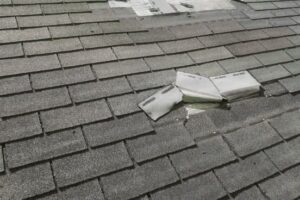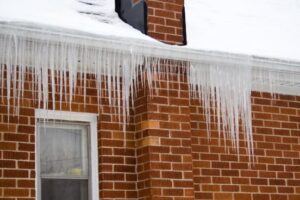Constant exposure to harsh weather – severe snow, hurricanes or tornadoes could definitely cause huge damage to your roof. With major roof repairs running anywhere from $1,500 to $7,000, you’ll definitely want to address roofing issues before it comes too severe.
What are the most common roofing problems? Roof leaks, damaged flashing and broken or missing shingles are some of the top roofing issues that many homeowners face. In this article, we will look at the top 10 common roofing problems and what you can do to fix or prevent them.
Top Most Common Roofing Problems
Roof Leaks
Damaged or Broken Shingles
Worn Out Flashing
Granule loss
Pooling Water
Snow Damage
Falling Branches
Punctures and Holes
Too Much Roofing Layers
Poor Installation
Roof Leaks
Leaks are one of the roofing problems that you just can’t ignore. Left unfixed, a simple roof leak could lead to a lot of internal damage and also leave stains and watermarks on the ceiling and walls. In addition, a leaky roof could cause mold and mildew buildup, which may pose danger to the people living in the home.
There are several reasons for roof leaks, such as cracked flashing, broken shingles, or tiles, and they could occur anywhere along the roof.

If you’re suspecting that your roof is leaking, some areas you can check are:
- Under damaged shingles
- Near the chimney
- Close the vents or pipes
- Flashing points
- Near the gutters
- In low spots or valleys
The tip is, a leak is often located a few feet away from the penetration. If you have an attic, head there with a flashlight and lookout along the rafters or roof sheathing. If you don’t have access to your attic, you should call a professional roofer to take care of the problem. As they say, “fixing a leaky roof is easy, tracking the source is the toughest part.”
Damaged or Broken Shingles
As with any part of the house, roof shingles will start to deteriorate due to the force of nature, wear and tear, and other factors. Because of these reasons, the sealants that are attaching your shingles will start to wear off causing them to break, loosen, or completely come off.
A quick fix would be to replace the damaged shingles. Some stores sell single shingles or you can also purchase a box to match and replace the existing ones you have. However, we would not suggest for homeowners to get on their roof and try to repair or replace it as there is also a safety risk involved. Plus, you could add more damage to the roof if you’re not sure of what you’re doing. Calling a pro to do the repairs is always the better idea.
Worn Out Flashing
Roof flashing is a thin metal or plastic that roofers install to move water away from vulnerable areas of your roof like chimneys, walls, or roof valleys. Flashing is necessary to prevent leaks and if the material has cracks, the fixtures will become exposed to water and moisture.
When you’re inspecting your roof, make sure to also check areas with flashing and if you see any damage, have it replaced with a new one. This may require some handyman skills as you will need to remove some materials surrounding the flashing to install a new one. If you’re unsure how to carry this out, you can always call the help of a roofing contractor.
Granule Loss
It could be worrying to see granules falling off your newly installed asphalt roof. However, granule loss is common on newly manufactured shingles for a few weeks.
What would be troubling is when you start seeing bald patches or you notice some discoloration on your asphalt roof. If this is happening to your roof, it is possible that the shingles are vulnerable to the elements and will start to crack. Another sign that you have this problem is when falling granules start to block your gutters. Either way, the best way to address this issue is to call a professional roofing contractor to inspect your roof. Do not put off having your roof replaced as this could lead to roof failure, which is a more expensive problem.
Pooling Water

Having a flat roof or allowing gutters to remain clogged are two of the reasons why some homeowners have pooling water on their roofs. And it’s no secret that stagnant water can damage the roof that could create mold or mildew and quickly deteriorate roofing material.
Schedule a regular gutter and downspout cleanup so water can freely fall down from the roof. For pooling water problems on a flat roof, we recommend having a contractor do preventive maintenance to avoid any structural damage.
Snow Damage
For homes located in areas that have freezing temperatures, it is expected that the roof lifespan is reduced.
Unfortunately, when ice water melts it only goes at a slow rate, which means water can stagnate and penetrate under the roof. Also when water freezes because of frigid temperatures, it expands and will push against the shingles, leaving an opening for water to come in.
There are three things homeowners can do to prevent damage on their roofs, particularly due to ice dams – first, manually remove ice (this is a safety risk, so it would be wise to trust the pros to do this), melt the ice from the roof with a heated cable, or preventing heat from leaving the roof through proper insulation.
Falling Branches
You’ll be surprised but we get a lot of homeowners looking to have their roof repaired because of falling tree branches. Take note that even small branches can cause issues when they rub against the roof for prolonged periods, as they could damage the top layer of the roof.
Remember to trim the trees near the roof, and if a tree poses a threat, it’s better to cut it down or transfer it to another area.
Punctures and Holes
Local wildlife (like a woodpecker drilling holes on your roof) and foot traffic are two of the main reasons for roof punctures. This may seem like a minor issue; however, these holes can expose the roof to leaks and can cause interior damage.
The best way to avoid this is to minimize foot traffic on the roof and also schedule regular roof maintenance to identify underlying issues such as this and address them immediately.
Too Much Roofing Layers
Old shingles getting worn out? Cover them with a new layer – right? Wrong. Most professional roofers would agree that putting a second set of shingles over existing ones (called layover), in most cases, is not advised.
Remember that roofs are designed to carry only a particular weight. Adding another layer will put more pressure and stress on the roof, which will lead to further damage. Also, a layover will only hide signs of damage on the roof, so you probably wouldn’t know if the first layer is already wearing out.
Instead of attempting to put another layer of shingles on your roof, have a pro check out the condition of your roof and be prepared to invest in a roof replacement.
Poor Installation
Another problem that some homeowners experience with their roofs is poor installation. Some would think that hiring an inexperienced contractor or taking the DIY route instead of a roofing professional is more cost-efficient. However, poorly installed roofs could cause short-life expectancy, recurring issues, and ultimately, roof damage.
Further Reading: Tips to Find the Ideal Roof Repair Company
What are the signs that a roof needs to be replaced?
While the common roofing problems mentioned above don’t necessarily call for a roof replacement, there are a few telltales signs that a roof needs to be replaced.

- If there is water damage in the attic or upstairs – Moisture marks, discolorations, and peeling paint on ceilings or walls are indications of roof damage.
- If the roof is past its lifespan – Asphalt shingles can last anywhere from 15 to 20 years, clay tiles can last an average of 40 years, and although more expensive than asphalt shingles, metal roofs have a life expectancy of 30 to 50 years.
- If the roof is sagging – Trapped moisture causes boards under the roof to rotand sag. A droopy roof is a clear sign that a roof is in dire need of replacement before it causes further damage to the house.
- If the shingles are already buckling or curling – Shingles that curl is an indication that they are no longer properly attached and have sustained damage.
- If your cooling or heating costs are going through the roof – Getting higher than usual cooling or heating bills could be caused by a leaky, damaged roof. Older roofs are less energy-efficient and could be a significant strain on energy costs.
What is the average cost to replace a roof?
Professional contractors calculate the cost to fix or replace a roof per square (100 square feet). Typically, a “per square” price on a bid already includes both material and labor. Several factors that affect the pricing of a roof replacement include roof size, roofing materials, labor costs (including tear-off time), roof slope, and other features.

To give you an idea, roof installation costs from $400 to $550 per square. The current national average for a roof replacement is $7,211 with most homeowners investing anywhere between $4,707 and $10,460.
Want to know how much it will cost to replace your old roof? Click here to get quotations from multiple professional roofing companies near you.
Takeaway
Your roof is one of the most important parts of your home – it protects you and your loved ones from the elements and it keeps you warm during winter and cool in the summer. It only makes sense that you pay close attention to its condition by scheduling regular roof maintenance and checkups. It’s also good to know about what issues to look out for, such as the ones we listed above, so that you’ll have minor issues fixed right away before they turn into a more expensive problem.




